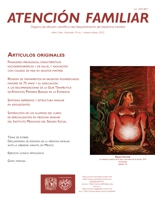Fragility: Prevalence, Social Demographic and Health Characteristics, and Association with Quality of Life in Elderly People
Main Article Content
Abstract
Objective: to understand the fragility stage of elderly who are attended at the Family Medicine Clinic (cmf) “Dr. Ignacio Chavez”, at the Institute of Security and Social Services for the State Workers (issste) and relate it with to socio-demographic and health factors, as well as quality of life. Material and methods: design: cross-sectional and analytical study. Population: random sampling for convenience in 253 adults aged over 60 years and more, who attend to medical consultation at the cmf “Dr. Ignacio Chavez” of the issste. Interventions: after signing a written consent, identification cards were used and two already validated questionnaires: criteria of Fried and coop/wonca vignettes. Statistical Analysis: Kruskal-Wallis and Mann-Whitney with 0.05 significance level was used to link variables and reason of Momios (rm) using the statistical spss program version 15. Results: the obtained prevalence of fragility was 44.3%, the feeling of exhaustion of 82.2% and the low level of physical activity of 73.5% were the most common criteria. There was a statistically significant relationship with all socio-demographic variables, as well as all dimensions of quality of life. rm obtained was 14.1 for age and 3.4 for arthritis. Conclusions: fragilty is a condition of high prevalence in elderly population, which significantly affects the quality of life of those who present it.
Downloads
Download data is not yet available.
Article Details
How to Cite
González Domínguez, R., & González Pedraza Avilés, A. (2011). Fragility: Prevalence, Social Demographic and Health Characteristics, and Association with Quality of Life in Elderly People. Atención Familiar, 19(1). https://doi.org/10.22201/facmed.14058871p.2012.1.29046
